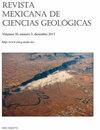北美洲、科科斯和加勒比板块的三重交汇处。我们知道什么,我们不知道什么
IF 0.5
4区 地球科学
Q4 GEOSCIENCES, MULTIDISCIPLINARY
Revista Mexicana De Ciencias Geologicas
Pub Date : 2022-07-26
DOI:10.22201/cgeo.20072902e.2022.2.1666
引用次数: 0
摘要
我们对北美-加勒比-科科斯三重交界区的构造元素进行了总结。在三重交界附近,与北美-加勒比板块边界有关的位移发生在左侧Motagua Polochic断层系统上,Cocos和其他两个板块之间的会聚发生在中美洲海沟上。Motagua-Polochic系统的踪迹在其最西端消失,并且没有到达收敛边界。然后,该位置的板块边界变形沿着一个反向断层系统(反向断层构造区)、一个左侧断层系统(走滑断层区)、两个或多个NW-SE方向的大型左侧断层(Angostura和Concordia断层)分布,以及一条左侧断层(Tonalá),该断层可能被解释为波洛奇断层沿恰帕斯地块南部边界的延续。在这个变形带的某个地方,北美和加勒比海之间的覆盖板块发生了转变,但具体在哪里还不清楚。它可能位于东经96°W左右,因为俯冲的科科斯板块的倾角和形状在该经度都发生了显著变化。本文章由计算机程序翻译,如有差异,请以英文原文为准。
The triple junction of the North America, Cocos, and Caribbean plates. What we know, what we don’t
We present a summary of the tectonic elements of the North America-Caribbean-Cocos triple junction area. In the vicinity of the triple junction, displacement related to the North America-Caribbean plate boundary takes place along the left-lateral Motagua-Polochic fault system, and convergence between the Cocos and the other two plates occurs along the Middle America trench.
The trace of the Motagua-Polochic system is lost at its westernmost end and does not reach the convergent boundary. Deformation of the plate boundary in this location is then distributed along a system of reverse faults (the Reverse-faults tectonic province), a system of left-lateral faults (Strike-slip faults province), two or more large NW-SE oriented left-lateral faults (Angostura and Concordia faults), and a left-lateral fault (Tonalá) that might be construed as the continuation of the Polochic fault along the southern border of the Chiapas Massif.
Somewhere within this deformation zone, transition in overriding plate between North America and Caribbean takes place, but it is not clear exactly where. It is probably at about longitude 96° W because both the dip and the shape of the subducted Cocos slab change significantly at this longitude.
求助全文
通过发布文献求助,成功后即可免费获取论文全文。
去求助
来源期刊

Revista Mexicana De Ciencias Geologicas
地学-地球科学综合
CiteScore
1.00
自引率
12.50%
发文量
0
审稿时长
6-12 weeks
期刊介绍:
Revista Mexicana de Ciencias Geológicas (RMCG) publishes original research papers on geological processes of broad interest, and particularly those dealing with regions of Latin America. The RMCG also publishes review papers on topics of current interest, and on the geology and tectonics of geological provinces of Latin America. Besides, it offers the opportunity for host editors to publish special thematic issues.
 求助内容:
求助内容: 应助结果提醒方式:
应助结果提醒方式:


